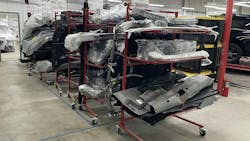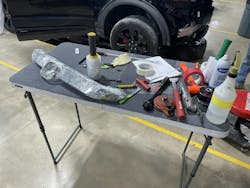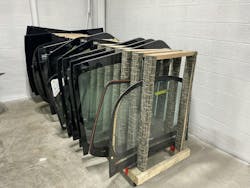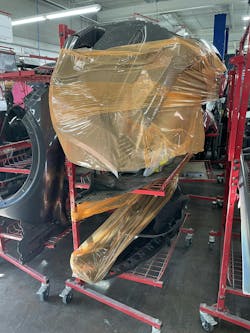Having run hundreds of performance groups over the past 40 years, I was challenged by FenderBender to recap the main topics the groups discuss. So, this will be a four-part series focusing on ideas to optimize Labor, Parts, Paint and Material and Sublet, and Overhead expense reduction.
Opportunity – Optimizing Parts Gross Profit
This article shares processes implemented by the performance group members who achieve the highest parts gross profit (given their work mix). Parts represent anywhere from 35-47% of various shops’ sales mix, and shops can expect to earn between 25-39% gross profit, depending upon their circumstances. Let’s explore the processes that optimize performance.
Negotiate a Win-Win Vendor Agreement
The obvious place to start when targeting optimal parts margin is the discount negotiated. Prior to entering win-win negotiations, you need to first ask yourself, “Am I a good customer?” “Do we provide clear information on the vehicle and its options and the specific parts needed for the repair?” “Have we proven to be a loyal customer and try to buy from a single source?” “Do we know the annual spend on the parts for the vehicle lines that dealer services?” Can you say with certainty, “We purchased $115,000 last year on the makes you supply?” Do we have a low “shop-caused” return rate – below 3%?
Approach the dealer from a win-win perspective showing genuine concern for the level of service provided. Go to the dealership and meet the staff and get to know them firsthand. How knowledgeable are the parts department staff members? How willing are they to use VIN decoding to ensure they know the vehicle options to ensure you have been getting the right parts? Do they understand cost/profit-matching, and are they offering to do so when realistic? Are their delivery trucks delivering on a routine which gets parts to you when needed, or could we be pushed to earlier on the route? Are they willing to put your estimate line number in the bin # or other part of their invoice to reduce time receiving parts? Finally, will they offer a market-competitive discount percentage, so you can invoice using the “receive all” feature of your management system?
Purchase Most from a Primary Vendor
After you agree to buy from the dealer, do a meet-and-greet with them to build relationships and commit to try to minimize the “hotshot” parts order and to be a proactive customer. Thank them when they do what you expected. Don’t take them for granted; they are a crucial partner in your business’s success. Reward them for their commitment by requiring your staff to buy most of the parts from them, even if the shop may have to occasionally eat a bit of margin by paying them a bit more for their part, to remain loyal. Review the purchases level internally and with them periodically to ensure the relationship remains positive. As part of this agreement, seek to get them to limit delivery and restocking fees.
Order Using Automated Parts Procurement System = Never Call in a Parts Order
One way to ensure you get paid for all the parts on a vehicle is to enter the part line in the estimating system and to use the designated parts procurement tool to place the order. Phone orders should only be accompanied by an automated request simultaneously.
Cost/ Profit Matching, NOT Price Matching
This is a tricky issue which costs quite a few shops a lot of gross profit on parts. In short, you are agreeing to buy an OEM part from the OEM supplier. In exchange, the OEM supplier is agreeing to provide you the same gross margin/cost as the alternative vendor.
NOTE: Example parts discounts below were kept the same, to make the example easier to follow.
If you bought an OEM part which wasn’t price matched: $500 - $350 Cost (reflects a 30% discount) = $150 profit on OEM part
If you would have ordered an aftermarket part: $400 – $280 Cost (30% discount) = $120 profit on aftermarket part
If the dealer agrees to cost/profit match, the dealer must price the product where their adjusted list price allows the shop to make the same $120 as they would if they bought the part from the aftermarket supplier. In this case, the new list price is $400 and your cost would be $280. Thus, they have matched the cost/profit of the aftermarket supplier.
Conversely, if you merely purchased the OEM part on your normal discount you would be reimbursed $400 and pay $350. You would earn only $50, which is a gross profit of 12.5% and a loss of $70 in parts profit on a single job!
Parts Storage
As vehicles are disassembled, we recommend two tables for parts to be stored: R & I and R & R. ONLY after the part line has been added to the estimating system are the parts to be stored properly on a parts cart. Parts carts should have a standard for how and where parts are stored on the shelves of a cart. Parts to be replaced should be marked in red or orange Uni Posca markings to visually remind the technician that the replacement part has not yet arrived. A PVC pipe should be attached to the cart for moldings to be stored flat and unable to be marred. J-hooks can hold larger parts so the parts for a vehicle are stored as a “kit.”
If you have the replacement part and can transfer parts to it, that is preferred, so time spent bagging and tagging is limited and missing parts are immediately identified. Glass should have the RO number added in Uni Posca marker and stored in a glass rack.
Limit Lost, Broken or Damaged Parts
Delicate parts should be shrink-wrapped, and if many parts are stored on a shelf, the entire stack could be shrink-wrapped so the cart can be transported without them falling off. Small parts like emblems should be stored in a container where larger parts cannot damage them. Every effort should be made (to include using small soft blankets on trim) to avoid damage to parts.
Parts Price Increases are Known
One of the nice features of the various parts procurement systems is the ability to get automated updates on part price increases. Noting those from these systems as you repair plan is the preferred moment to update the estimating system to avoid a parts price increase supplement later. Hold the supplement until the parts prices are verified, as it will save time and ensure you get paid the updated list price!
Checking Parts Status
Another important service level the dealer and shop parts person need to maintain relates to the expected date of delivery (EDD). The parts person needs to proactively give thought to when they need the parts. It may be ASAP, or it may be one day prior to the vehicle’s arrival. If the parts person feels the dealership cannot meet that EDD, then they need to proactively call the shop and inform them. This is especially important if it is a critical part, as that allows the shop to adjust incoming vehicle schedules accordingly.
Parts Receiving
Dealers need to understand your expectation of a win-win delivery and the driver's expectations. Receiving the parts is NOT the act of dropping them off and getting an invoice signed; it is so much more. Here are the steps to best-case delivery process:
- Parts are brought into the parts room and counted to be certain the number purchased matches the invoice (they may still be on the truck or were never loaded)
- Look at each box to review the part number (if the part number is different than you ordered, that is an instant trigger to verify the part closely). Also examine the box for obvious signs of damage (which should trigger you to open it and verify it is not damaged).
- Place on your receiving table. Open each box and 720-degree mirror match the part, looking closely at the entirety of the exterior and interior of the part comparing mounting points and features.
- If a wrong or damaged part is uncovered, call the vendor immediately and have them remove the line from the invoice and have them email an updated invoice for you to sign instead of signing the invoice with the wrong or damaged part. Ask them to reload the wrong or damaged part to avoid the steps to return the part.
- Have the vendor review and sign the return slips for parts pending return
- Sign the invoice and the driver continues on.
- Place the received parts on the parts cart and dispose of the damaged part (unless a core is required or there is reason to keep it) and dispose / recycle of the box for the part you have received.
Why is it acceptable to throw away the box as we receive parts? It is assumed we have verified we need the part and don’t plan on returning it. If it turns out it is not functioning or damaged, we need to order a new part, and that comes in a box we can use for the return!
Returns - Limit “Just in Case” parts
During COVID due to parts shortages, we may have developed some bad parts ordering habits. One we need to stop is the ordering parts “just in case.” Asking vendors to procure this part from its manufacturer, to deliver them, receive them, store them and pay for them, only to go through the eight to 10 steps to return them and receive the credit is quite a cost – just in case. Take the time to perform an advanced inspection prior to ordering parts for the vehicle.
Salvage Parts
Salvage parts are another area where parts margin can be boosted. One of the most important criteria when selecting a part is the color of the donor vehicle. If the color matches, it saves so much time in preparation (less prep and less base to change the color), but you do have to consider parts quality as well. Most salvage yards are members of ARA, and they grade their parts as they post them as available. As you order from preferred yards (or any yards), that grade needs to be considered. If you order a “B” or “C” part, expect to closely inspect the part and then receive it at the higher list price. Then negotiate a labor parts credit that reflects fair reimbursement (2.0 hours * $80 = $160 labor credit off invoice) for repairing any dings and dents the part may have on it. Also, deduct some percentage (i.e. 20% - .4) of that 2.0 hours for materials and then create a 1.6-hour repair line on the estimate to reimburse the technician for those repairs.
Focus on Aftermarket Parts
Obviously, all aftermarket parts need to be closely mirror-matched and fit-tested before they EVER get painted. This slows the overall repair cycle, so it should be considered when selecting part type… Beyond following the above processes relative to body parts, an often-underemphasized area of the aftermarket parts category relates to the clips, fasteners, bulbs, and fluids or stock parts classified here on the estimating system. As you disassemble, it is important when you identify the as-damaged or lost (at accident scene or elsewhere) to use the bar code reader in your clip and fastener system or the kit or individual item in the 3M Repair Stack tool. Then generate an invoice for these parts to assure you get paid for the parts your staff will be using to reassemble the vehicle to be safe to drive. Many repairers are too “busy” to get paid for this. But they walk away from aftermarket parts sales and profits.
Reconciliation
If you did all the above steps, the reconciliation of the monthly vendor statement should be a breeze. By receiving complete parts orders and ensuring accurate discounts,the invoices should be accurate. Immediate returns and the reissue of invoices should prevent tons of dealer-caused returns. Having them sign the return receipts should make it easy to prove the date of the return pick-up and therefore the credit expectation. Once the statement is reconciled, the AP payment is scheduled, and hopefully promptly!
Prompt Payment
All of the part suppliers want to get paid in a timely manner., Be a smart operator and budget cash flow to be able to fully pay these vendors in the “X” day window (billed on the 25th and paid by the 10th) they require to earn an additional percentage (often 2%) for paying promptly; this only enhances the discount and thus the final margin on the monthly profit and loss statement.
Conclusion
With parts being 35-48% of sales and margins between 25 and 39%, there is a lot of opportunity to negotiate better, store parts better to prevent damage, order only the parts necessary, receive only useful parts, get paid for labor credits, and other improvements to optimize parts profits. This requires someone to focus on these processes and stay on top of them daily so the individual jobs’ parts margins add up to the goal you have set for yourself!
About the Author
Steve Trapp
Steve Trapp is an internationally known consultant and speaker. His family operates a collision repair center in Wisconsin. He earned a degree in economics education and a minor in accounting from the University of Wisconsin.
After college, he worked for 3M in sales and marketing roles with the innovative 3M ARM$ training and software sales. He worked as a consultant for AutocheX doing financial consulting for a few years before joining AkzoNobel, where he started the industry’s first value-added program. While there, he started the industry’s first paint company-sponsored 20 groups and wrote numerous training programs with third-party experts on finance, marketing, selling, leadership, and other topics.
He later joined DuPont/Axalta, where he worked with Mike Anderson to manage their 20 groups and industry seminars. While at Axalta, he managed the North American Strategic Accounts SAM team and later the entire EMEA Strategic Accounts team. He followed that as senior consultant for LEAP, a global consulting firm that has presented in 10 countries and now again works for a major paint company.




